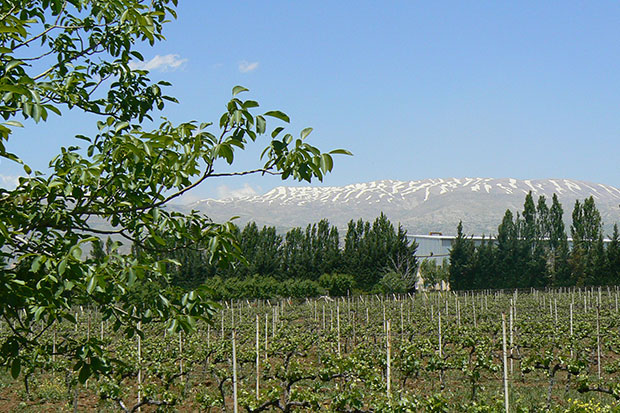Last week’s Spectator Winemaker’s Lunch with Sami Ghosn of Massaya was an instant a sell-out. For some reason it was also our first ever all-male lunch; more fool the girls, for Sami is nothing if not a charmer and his wines are outstanding.
Almost everyone has heard of Chateau Musar, which famously blazed the Lebanese wine trail, and very fine its wines are too. My late, greatly lamented predecessor, Simon Hoggart, was a huge fan and we ran a very successful Musar offer only the other week. Massaya (meaning twilight) might not boast Musar’s history, being a relatively new kid on the block, but it has been a true game changer and has done much to bring Lebanese wines to a wider audience. Where Musar led, Massaya followed in dramatic style.
Many folk new to Musar and Massaya are surprised that Lebanon can make wine at all but, as Sami explained over lunch, certain well-documented human conflicts aside, the Lebanon is a blessed place to grow grapes and make wine.
The Massaya vineyards are at Tanail in the Bekaa Valley and at Faqra on Mount Lebanon. The climate is so benign – hot days, cool nights – that no irrigation is needed, nor pesticides, nor fertilisers.
‘We’ve some of the oldest vineyard sites in the world in the Lebanon,’ Sami explained. ‘The Phoenicians made wine here. And although humans and politics make life difficult in our country, nature is remarkably kind to us. In that respect, it’s about as perfect a place to make wine as one can imagine. We get wonderful fruit and there’s so little we need to do to it. The vines are neither too stressed nor too comfortable. They’re just happy.’
The Maronite Christian Ghosn family were forced to flee the Lebanon in the 1970s, but Sami and his brother Ramzi returned to the family estate from France and the USA in the mid ’90s and, spotting its potential, persuaded their uncle not to sell it. The estate was derelict and overrun with squatters, Sami told us, and he spent four months sleeping on the roof of his old home with an AK47 as a bedfellow.
Sami and his brother started by making arak, a thundering success thanks to its fine quality and the tall, cool, elegant, eye-catching deep blue bottle they put it in (a bottle of which Sami brought with him to our lunch). One day a cork seller came calling. Sami tried to send him away, telling him that he had no need of corks as he didn’t make wine. The cork seller told him that one day he would and that he wanted to be the provider of the corks that Sami would then need.
Sami said that he would buy some corks if the cork seller could introduce him to the top names in Bordeaux. To cut a long story short, Sami ended up meeting Dominique Hebrard, then of Ch. Cheval Blanc and now of Ch. Trianon. Dominique agreed to visit the Ghosn estate and promptly invested both money and expertise. Realising that his Lebanese terroir was better suited to Rhône-style wines, Sami then contrived also to meet the Brunier brothers of Vieux Télégraph, Châteauneuf-du-Pape. They too invested money and expertise and so Hebrard and the Bruniers changed Lebanese wine forever.
Massaya now exports its wines to over 20 countries. ‘We portray the civility of the Lebanon,’ said Sami. ‘Our country is a crazy mix of misunderstood minorities. We might be a ridiculously tiny country but our food is enjoyed the world over, having the widest reach of any cuisine. Our wines can now match that.’
Well I can certainly vouch for the quality of Massaya’s wines. We started with the delicious 2015 Massaya Blanc (£14.90), a blend of Clairette, Sauvignon Blanc, Chardonnay and the local Obeidi – a blend you’ll not see anywhere else in the world. From high altitude vineyards on Mount Lebanon, it’s vibrantly fresh and characterful; fruity but with a long savoury finish.
The 2015 Massaya Rosé (£14.90) is a blend of 30 year-old Cinsault, Syrah and Cabernet Sauvignon and is as tasty a pink as I’ve had in ages, full of ripe, summery, wild strawberry fruit with a crisp dry finish. If I’d had it in a blind tasting I’d never have guessed it was from Lebanon.
Then followed the four reds in the Massaya range: the 2013 Massaya Le Colombier (£11.95), the 2012 Massaya Terrasses de Baalbeck (£19.70), th 2013 Massaya Cap Est (£30.95) and, finally, the majestic 2010 Massaya Gold Reserve (£34.95). All hit the spot just so, matching the fine Forman & Field lunch perfectly. It must be said, though, that the Gold Reserve quite silenced the room. A blend of 50 per cent Cabernet Sauvignon, 40 per cent Mourvèdre and 10 per cent Syrah, it’s a wine of complex, brooding power. It’s full-flavoured, of course, but remarkably fresh too with wonderfully intense sweet briary fruit and a long, long savoury finish. A Rhône or Bordeaux of similar quality would be twice the price at least.
Sami Ghosn proved himself to be a hugely engaging advocate not only for the wines of Massaya but also for the wines of the Lebanon in general. If you haven’t yet discovered them, please do. The range is available at Tanners of Shrewsbury. Visit www.tanners-wines.co.uk or call 01743 234455.







Comments